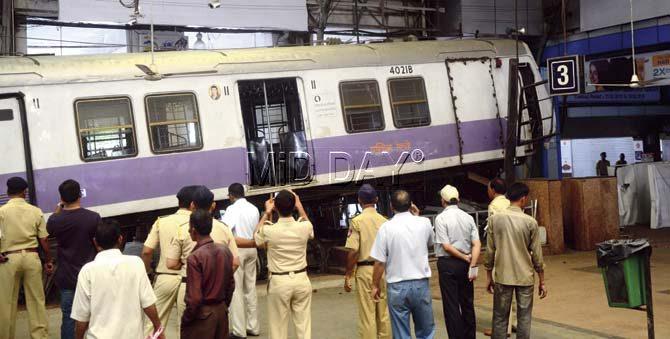Railway authorities are mulling installing inductors, consisting of magnets, on tracks ahead of major terminuses on WR and CR to ensure that the brakes on trains are automatically applied if they are at a high speed

After the ‘flying local’ was finally made to land on the tracks with much difficulty, the railway authorities are mulling the idea of fitting special magnets ahead of rail terminuses on the Western and Central railway networks to ensure Sunday’s incident remains the last of its kind.
ADVERTISEMENT

This fast train from Bhayander, dubbed the flying local by commuters, had overshot the tracks and part of it had landed on platform no 3 of Churchgate station on Sunday morning. Pic/Bipin Kokate
mid-day had reported yesterday how more than half of the ladies’ coach of a fast local from Bhayander literally flew off the tracks and came to rest on platform no 3 of Churchgate station around 11.20 am on Sunday, giving commuters the shock of their lives.
Watch video:
![]()
Railway officials said that later the same night when work on getting the hanging train down, levelling the tracks and repairing the platform was still underway they had already begun mulling ways to ensure that such an accident never happens again.
“One of the methods that was thought of was to install inductors (consisting of a permanent magnet and an electromagnetic one) as part of the existing Auxiliary Warning System (AWS) near terminuses, which can clamp down on the brakes if the driver fails to do so in time,” said a Western Railway official.
He added that the inductors would be installed on the tracks before terminuses like Churchgate, Chhatrapati Shivaji Terminus, Thane, Dadar and Andheri, among others, which serve as end points for local trains and where buffers have been placed for protection.
Spreading the system
mid-day had reported on February 9 (‘WR installs track magnets to reduce train delays’) how the inductors allow the motorman to know the status of an upcoming signal in advance, allowing him to increase or decrease the speed of the train accordingly.
While the inductors help speed up the working of the railway network, the AWS, which they are a part of, can also prevent disasters by automatically applying the brakes if a motorman fails to do so in time (see box). WR sources said they had installed around 170 inductors on the Churchgate-Virar stretch, but none of these were placed near the terminuses.
“We are thinking of installing inductors and allowing the AWS to work at terminus stations too. If a train exceeds the permissible speed, then automatic brakes will be applied,” said SK Sood, General Manager, Central and Western Railways.
Trading speed for safety
Officials added, however, that doing so could affect the punctuality of trains. “Presently, trains enter Churchgate station at 30 kmph. With the AWS in place there, trains may run at lower speeds as the magnets may slow down an incoming train, affecting punctuality and our ability to stick to the sch-edule,” explained a WR official.
Quick turnarounds
With platform no 3 unavailable at Churchgate yesterday in the wake of Sunday’s accident, WR officials reduced the turnaround time of local trains by more than half to ensure they could run more services.
Only three platforms were available for local trains and authorities positioned motormen, guards and other staff near the spot where the motorman’s cabin arrives to ensure they could conduct the necessary checks swiftly.
As soon as the train entered a platform, these men would complete the checks in 2 minutes, instead of the 5-7 minutes it usually takes for a motorman to complete them.
Thanks to these measures, WR could operate around 13 services per hour per platform from Churchgate during peak hours, instead of the usual 10. They also managed to run around 9 services per platform per hour during off-peak hours instead of the usual 7. WR still had to, however, cancel 50 train services because of the platform remaining unavailable.
How it works
Auxiliary Warning System (AWS) tells the motorman about the status of the next signal even before he can see the signal post. The inductors on the track, fitted around 180 metres before a signal, sense its status red, yellow, double yellow or green and then pass on the information to the motorman when the train passes over it.
Sources said the motorman gets a warning to reduce his speed when the signal is red or yellow, but gets to maintain, or even increase, it if the signal is double yellow or green. This helps enhance punctuality of trains by preventing a moto-rman from having to decre-ase his speed each time.
Built-in safety measures in the AWS can also automatically apply brakes to the moving train if the motorman fails to notice a red signal, and warn the motorman if he crosses a signal that is yellow.
 Subscribe today by clicking the link and stay updated with the latest news!" Click here!
Subscribe today by clicking the link and stay updated with the latest news!" Click here!






